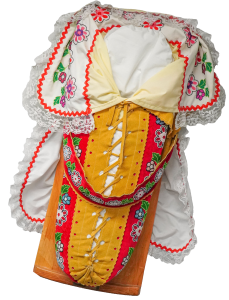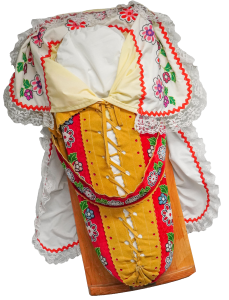History
Working Together For Over 35 Years

Tikinagan was one of the first Indigenous-controlled agencies in Canada. It was the first Indigenous agency recognized as a child protection organization in Ontario along with Payukotayno Family Services and the first in Canada to have jurisdiction over both Indigenous and non-Indigenous children.
Tikinagan was created to provide culturally-specific child and family services that emphasize an Indigenous approach to child welfare. Previously, services to support and care for Indigenous children and their families originated from outside the Indigenous community.
In this region, these services were delivered by a non-Indigenous CAS with minimal presence at the community level. Non-Indigenous workers who did not speak the native language visited the communities only in response to crisis situations – to investigate reports of child abuse and to apprehend children. Children who were apprehended were taken from parents and a tightly-knit community of extended family members and neighbours with a unique, distinctive familiar culture and then placed in non-Indigenous foster homes in southern urban communities.
Indigenous people speak with passion about the manner in which their children were swept away from home communities under the guise of protective services. The 1980 Report of the Canadian Council on Social Development reported that Indigenous children comprised more than twenty percent of the total number of children in care, while people of Indigenous background account for only six percent of the Canadian population. As well as temporary removal, many children were removed permanently from their home communities and adopted by non-Indigenous families. Removing children from their families broke their connection with their home community and its circle of support and their cultural background. First Nations saw the “loss” of these children as one of the most tragic consequences of non-Indigenous control of child welfare services.
To prevent past practices from recurring and to improve services for Indigenous children, families and First Nation communities, sections dealing with provision of services to Indigenous people were added to the Child and Family Services Act in 1984. These amendments, contained mostly in Part X of the Act, allowed for the establishment of Indigenous-run child and family service agencies as well as the use of agency subsidized customary care arrangements.
The Chiefs of this region acted quickly on the opportunity to gain control over child and family services. In 1984, the Chiefs of NAN and the Government of Ontario signed a Memorandum of Agreement outlining their mutual intent to move toward full Indigenous control over child welfare services. The agreement provided for the takeover of Child and Family Services by the Indigenous people of NAN and established a framework for the creation of Tikinagan.
Tikinagan Child and Family Services was incorporated in October 1984. In June of 1985, the parameters of the agency were established and some service delivery of a preventive nature was initiated. In April 1986, Tikinagan was given approved agency status and on April 1, 1987, Tikinagan received designation as a Children’s Aid Society with responsibility for all child and family services within its geographical territory.
Tikinagan was founded on two basic principles, as handed down by the chiefs. First, “that no more children be lost from our communities.” Second, “that a child and family service agency be created that would work with the people for the people, while respecting culture, heritage, and the concepts of the extended family.”
ᑎᑭᓇᑲᐣ ᐊᒥᐦᐅᐁᐧ ᑭᐣ ᑭᑕᐊᐧᔑᑦ ᒥᓇ ᑎᐯᐣᒋᑫᐃᐧᐣ ᐱᒧᒋᑫᐃᐧᐣ

ᑲᑭ ᒪᒋᒋᑲᑌᐠ ᐁᑭ ᒪᒋᑐᐊᐧᐨ ᑭᑎᐡᑯᓂᑲᓂᓇᐣ ᐅᒋ ᒪᒋ ᐅᐱᒪᐦᐊᒧᐃᐧᐱᓯᑦ 1984 ᐁᑭ ᐸᑭᑎᓇᒧᐊᐧᐨ ᒪᓯᓇᐦᐃᑲᐣ ᐅᑭᒪᑲᐣ ᒍᓴᔭᐡ ᐱᐟᓫᐃᕑ, ᐸᐧᔾᓫᐊᐟ ᒪᔑᒥᑎ ᒥᓇ ᐃᐧᓂᔭᑦ ᓇᑎᐣᐠ – ᑎᑭᓇᑲᐣ ᓂᑕᑦ ᐅᑕᐱᑕᒪᑫᒪᐣ.
ᐁᑭ ᐅᓇᒋᑲᑌᐠ ᓂᔑᐣ ᑫᑯᓇᐣ ᐁᑭ ᐱᒥᓂᔕᐦᐊᒧᐊᐧᐨ, ᑲᑭ ᐸᑭᑎᓇᒧᐊᐧᐨ ᐅᑭᒪᑲᓇᐠ. ᓂᑕᑦ, “ᐁᑲ ᐊᐊᐧᔑᒣ ᐊᐊᐧᔑᔕᐠ ᒋᐊᐧᓂᐦᐊᑲᓄᐊᐧᐨ ᑭᑕᔑᑫᐃᐧᓂᓇᐣ.” ᓂᔑᐣ, “ᐃᐁᐧ ᐊᐊᐧᔑᐠ ᒥᓇ ᑎᐯᐣᒋᑫᐃᐧᐣ ᐱᒧᒋᑫᐃᐧᐣ ᒋᐅᓇᒋᑲᑌᐠ ᑫᐃᐧᒋᐦᐃᑯᐊᐧᐨ ᐊᓂᔑᓂᓂᐊᐧᐠ, ᒥᓇ ᑲᔦ ᐊᔑᐨ ᒋᑭᑌᐣᑕᒋᑲᑌᐠ ᐊᓂᔑᓇᐯᐊᐧᑎᓯᐃᐧᐣ, ᐅᑕᓇᐣᐠ ᑲᑭ ᐱᑐᒋᑲᑌᑭᐣ, ᒥᓇ ᑲᐃᔑ ᑲᓇᐊᐧᐸᐣᒋᑲᑌᑭᐣ ᑲᐊᐧᑯᒪᐊᐧᐨ ᑎᐯᐣᒋᑫᐃᐧᓇᐣ.” ᐅᑫᐧᓂᐊᐧᐣ ᑲᐱᒥᓂᔕᐦᐃᑲᑌᑭᐣ ᐊᒥᐱᑯ ᑭᔭᐸᐨ ᐁᐱᒥ ᑭᑭᓄᐡᑲᒪᑫᒪᑲᑭᐣ ᓂᑕᓄᑭᐃᐧᓂᓇᐣ ᓄᑯᑦ ᒥᓇ ᐁᐣᑕᓱᑭᔑᑲᐠ.
ᑲᑭ ᐅᔑᓂᑲᑕᐠ ᐅᑭᒪᑲᐣ ᐦᐊᕑᐱ ᔦᐡᓄ ᐃᔭᐱᒪᑐᐣᐠ ᑲᐅᒋ ᑎᐯᐣᑕᑯᓯᐨ “ᑎᑭᓇᑲᐣ” – ᐁᐅᒋ ᑭᑭᓇᐊᐧᒋᒋᑲᑌᐣ ᐸᒥᐦᐃᐁᐧᐃᐧᐣ ᒥᓇ ᑲᓇᐁᐧᐣᑕᑯᓯᐃᐧᐣ ᐃᐁᐧ ᑎᑭᓇᑲᓇᑎᐠ ᑲᐊᐸᒋᑕᒧᓂᑯᔭᐠ ᑲᐊᓂ ᒪᒋᐱᒪᑎᓯᓇᓂᐊᐧᐠ.
ᓂᑎᔑᓇᒧᐃᐧᓂᓇᐣ ᐅᑭᒪᑲᓇᐠ ᐅᑭ ᐅᓇᑐᓇᐊᐧᐸᐣ, ᑕᔑᑫᐃᐧᓇᐣ ᒥᓇ ᑲᔦ ᑭᒋᔭᐦᐊᐠ: “ᐊᐁᐧ ᒪᓂᑐ ᑭᑭᑌᐸᑫᓂᒥᑯᒥᐣ ᑲᑲᓇᑕᐠ ᒋᐸᐸᒥᓯᔭᐣᐠ ᒋᑲᓇᐁᐧᓂᒪᔭᐠ ᐊᐊᐧᔑᔕᐠ, ᒋᐅᔑᑐᔭᐠ ᒥᓇ ᒋᑭᒋᐃᐧᓇᒪᐠ ᑲᒪᐡᑲᐊᐧᑭᐣ ᑎᐯᐣᒋᑫᐃᐧᓇᐣ, ᒥᓇ ᒋᐃᐧᒋᑐᔭᐠ ᑲᒥᓀᐧᔭᒪᑲᑭᐣ ᑕᔑᑫᐃᐧᓇᐣ. ᐃᑫᐧᓂᐊᐧᐣ ᑭᑕᔑᑫᐃᐧᓂᒥᓇᐣ ᐁᐧᑎ ᐃᔑᓂᑲᐣ ᐃᑫᐧᓂᐊᐧᐠ ᑭᓂᒐᓂᔑᓇᐣ ᑫᓇᐣᑕᐁᐧᐣᑕᒧᐊᐧᐨ ᑲᐧᔭᐠ ᒋᐅᑦᐱᑭᐦᐃᑯᐊᐧᐨ ᑲᐅᒋ ᑎᐯᐣᑕᑯᓯᐊᐧᐨ ᒥᓇ ᑲᔦ ᐅᑕᔑᑫᐃᐧᓂᐊᐧᑲᐣᐠ. ᑎᑭᓇᑲᐣ ᐊᐊᐧᔑᐡ ᒥᓇ ᑎᐯᐣᒋᑫᐃᐧᐣ ᐱᒧᒋᑫᐃᐧᐣ ᐅᑭ ᒪᒋᑐᓇᐊᐧᐸᐣ ᐅᑭᒪᑲᓇᐠ ᐊᓂᔑᓇᐯ ᐊᐡᑭ ᑲᐅᒋ ᑎᐯᐣᑕᑯᓯᐊᐧᐨ. ᑕᔑᑫᐃᐧᓇᐣ ᐃᐧᐣ ᐸᐸᒥᓯ ᒋᑲᓇᐁᐧᐣᑕᑯᓯᐊᐧᐨ ᐊᐊᐧᔑᔕᐠ ᒪᐊᐧᐨ ᐃᐁᐧ ᑲᑭᒋᓀᐣᑲᐧᐠ ᑭᑕᓂᔑᓂᓂᐃᐧ ᑎᐯᓂᒥᑎᓱᐃᐧᓂᓇᐣ.”
ᑲᐱᒥᓂᔕᐦᐊᒪᐠ ᒥᓇ ᑲᑭᒋᓀᐣᑕᒪᐠ ᐅᒋ ᑭᑭᓇᐊᐧᒋᒋᑫᒪᑲᐣ ᑭᑕᔑᓂᓂᐊᐧᑎᓯᐃᐧᓂᓇᐣ ᒥᓇ ᑭᑕᓂᔑᓂᓂᐃᐧ ᑐᑕᒧᐃᐧᓂᓇᐣ. ᐊᒥ ᐅᑫᐧᓂᐊᐧᐣ ᑲᔦ ᑲᑭ ᐅᓇᑐᐊᐧᐨ ᑭᑐᑭᒪᑲᓂᓇᐣ, ᑕᔑᑫᐃᐧᓇᐣ ᒥᓇ ᑭᒋᔭᐦᐊᐠ. ᐃᒪ ᑕᐡ ᑭᑐᒋ ᑭᑭᓄᐡᑲᒪᑯᓇᐣ ᑲᐃᔑ ᑌᐯᐧᔦᐣᑕᒪᐠ ᐃᒪ ᐃᐧᒋᐦᐃᑯᐃᐧᓇᐣ ᐁᐊᔭᑭᐣ ᑭᑕᔑᑫᐃᐧᓇᐣ.
ᑲᐅᒋ ᐅᓇᔓᐊᐧᑌᑭᐣ 30 ᑲᐅᒋ ᑎᐯᐣᑕᑯᓯᐊᐧᐨ– ᐯᐯᔑᐠ ᐅᑭᒪᑲᓇᐠ ᑲᑕᓱ ᐸᐯᔑᑲᐧᑭᐣ ᐃᐡᑯᓂᑲᓇᐣ ᐃᒪ ᑲᐅᒋ ᐊᓄᑲᑕᒪᐣᐠ ᑲᐅᒋ ᑎᐸᒋᒧᑕᐊᐧᔭᐣᐠ ᒥᓇ ᑲᐅᒋ ᐅᓇᔓᐊᐧᓂᑯᔭᐣᐠ ᐃᒪ ᑕᓯᐊᐦᑭ ᐅᑭᒪᑲᓇᐠ ᐅᒪᐊᐧᒋᐦᐃᐧᓂᐊᐧ ᐃᒪ ᐯᔑᐠ ᐃᐡᑯᓂᑲᓂᐠ ᑲᑭ ᑕᔑ ᒪᐊᐧᒋᐦᐃᑎᐊᐧᐸᐣ.
ᑲᓂᑲᓂᐡᑲᒧᐊᐧᐨ ᐅᑕᐱᑕᒪᑫᐠ ᑲᑭ ᐅᓇᑭᒥᑯᐊᐧᐨ ᐅᑭᒪᑲᓇᐠ– ᑲᑭᓇ ᐅᑕᐱᑕᒪᑫᐠ ᐃᔑᓇᐣᑕᐁᐧᐣᑕᑯᓯᐊᐧᐠ ᐃᒪ ᒋᐅᒋ ᑎᐯᐣᑕᑯᓯᐊᐧᐨ, ᒋᔑᑲᐯᔑᐊᐧᐨ, ᐃᒪ ᐯᔑᐠ ᐃᐡᑯᓂᑲᓂᐠ ᑲᐅᒋ ᓇᓇᑲᒋᑐᔭᐣᐠ. ᐃᑫᐧᓂᐊᐧᐠ ᐅᑕᐱᑕᒪᑫᐠ ᐃᒪ ᐅᒋ ᐅᓇᔓᐊᐧᓇᐊᐧᐠ ᑭᑎᐡᑯᓂᐃᐧᑭᒪᑲᓇᐠ ᐁᐅᒋ ᑫᒋᓇᒋᑲᑌᐠ ᐅᐁᐧ ᐱᒧᒋᑫᐃᐧᐣ ᒥᓇ ᐅᐃᐧᒋᐦᐃᐁᐧᐃᐧᓂᐊᐧ ᒋᐱᒥᓂᔕᐦᐃᑲᑌᐠ ᑲᑭ ᐃᓀᐣᑕᑲᐧᐠ ᒋᐃᔑ ᐱᒥᐃᐧᒋᑲᑌᐠ, ᐃᔑᓇᒧᐃᐧᐣ, ᒥᓇ ᑲᔦ ᑲᑭᒋᓀᐣᑕᑲᐧᑭᐣ.
ᑭᑭᓄᐡᑲᒪᑫᐃᐧᐣ ᑭᒋᔭᐦᐊᐠ ᑲᐊᐱᑕᒪᑫᐊᐧᐨ ᒥᓇ ᑲᔦ ᐅᐡᑲᑎᓯᐃᐧ ᐊᐱᑕᒪᑫᐃᐧᐣ ᐃᒪ ᐁᑭ ᐅᒋ ᐅᓇᑭᒪᑲᓄᐊᐧᐨ ᐃᐡᑯᓂᑲᓇᐣ ᑲᐅᒋ ᐊᓂᑲᑕᒪᐣᐠ. ᐃᑫᐧᓂᐊᐧᐠ ᑲᑭᒋᔭᐦᐊᐃᐧ ᐊᐱᑕᒪᑫᐊᐧᐨ ᒥᐦᐃ ᐅᑫᐧᓂᐊᐧᐠ ᑲᐱᒧᑐᐊᐧᐨ ᐃᔑᓇᒧᐃᐧᐣ ᒥᓇ ᑲᔦ ᐁᐸᐸᒥᓯᑲᑕᒧᐊᐧᐨ ᑫᔑ ᐱᒥᐃᐧᒋᑲᑌᐠ ᐅᐁᐧ ᐱᒧᒋᑫᐃᐧᐣ ᑲᐧᔭᐠ ᒋᐃᓯᓭᐠ ᒥᓇ ᒋᐱᒥᓂᔕᐦᐃᑲᑌᐠ ᓂᑕᑦ ᑲᑭ ᐃᓀᐣᑕᑲᐧᑭᐸᐣ ᒋᐃᓇᑌᐠ. ᐃᑫᐧᓂᐊᐧᐠ ᑲᐅᐡᑲᑎᓯᐃᐧ ᐊᐱᑕᒪᑫᐊᐧᐨ ᒥᐦᐃ ᐅᑫᐧᓂᐊᐧᐠ ᐁᔕᑯᐁᐧᑕᒪᑫᐊᐧᐨ ᓂᑲᐣ ᑫᑯᓇᐣ ᒥᓇ ᐁᐅᒋ ᐸᐸᒥᓯᑲᑕᒧᐊᐧᐨ ᑫᐃᓯᓭᑭᐣ ᐃᐧᒋᐦᐃᐁᐧᐃᐧᓇᐣ ᑕᐱᓇᑲ ᐃᐧᓂᐊᐧ ᐅᑭᑫᐣᑕᓇᐊᐧ ᐊᓂᐣ ᑫᔑ ᒥᓄᓭᐦᐃᑯᐊᐧᐨ ᑲᑭᓇ ᐊᐊᐧᔑᔕᐠ, ᐅᐡᑲᑎᓴᐠ ᒥᓇ ᑎᐯᐣᒋᑫᐃᐧᓇᐣ.
ᑲᐅᒋ ᐱᒧᑐᐊᐧᐨ ᑭᑕᓂᔑᓂᓂᒥᓇᐣ. ᐃᑫᐧᓂᐊᐧᐠ ᑲᐅᑭᒪᐊᐧᑭᓱᐊᐧᐨ ᑌᓫᒪ ᒪᐧᕑᐃᐡ ᑲᓴᐸᓇᑲ ᐅᒋ ᑎᐯᐣᑕᑯᓯ ᐃᐧᐣ ᑲᓂᑲᓂᐡᑲᐠ. ᑲᑭᓇ ᓂᔭᓇᐣ ᐃᒪ ᑲᐅᑭᒪᐊᐧᑭᓱᐊᐧᐨ ᒥᐱᑯ ᐃᒪ ᐁᐅᒋ ᑎᐯᐣᑕᑯᓯᐊᐧᐨ ᑭᑎᐡᑯᓂᑲᓂᓇᐣ ᐁᑲᐧ ᑲᔦ 70% ᑲᐅᑭᒪᐊᐧᑭᓱᐊᐧᐨ ᒥᐦᐃᒪ ᐁᐧᐣᒋ ᑎᐯᐣᑕᑯᓯᐊᐧᐨ ᐃᐡᑯᓂᑲᓂᐠ ᑲᐅᒋ ᐊᓄᑲᑕᒪᐣᐠ.
ᑲᐊᓄᑭᑕᒪᑫᐊᐧᐨ ᑭᑕᓂᔑᓂᓂᒥᓇᐣ – ᐊᐊᐧᔑᒣ 75% ᓂᑕᓄᑭᓇᑲᓂᓇᐣ ᐃᐡᑯᓂᑲᓂᐠ ᐅᒋ ᑎᐯᐣᑕᑯᓯᐊᐧᐠ ᐃᒪ ᑲᐅᒋ ᓇᓇᑲᒋᑐᔭᐣᐠ ᒥᓇ ᑲᔦ ᑫᑲᐟ ᐊᐱᑕ ᐃᒪ ᐃᔑᑲᐯᔑᐊᐧᐠ ᒥᓇ ᑕᓇᓄᑭᐊᐧᐠ ᐃᒪ ᐃᐡᑯᓂᑲᓂᐠ ᑲᐅᒋ ᓇᓇᑲᒋᑐᔭᐣᐠ. ᐁᑲᐧ ᑕᐡ ᑲᓇᓇᐣᑎᓇᐊᐧᔭᐠ ᑫᐊᓄᑭᑕᒪᑫᐊᐧᐨ, ᑲᐃᐧᓂᓂᑯ ᐁᑕ ᐊᓀᐱᒋ ᑭᑫᐣᑕᓯᐨ ᓂᑎᔑ ᓇᓇᐣᑎᓇᒥᓯᐣ ᒥᓇ ᑲᑭᐱᔑ ᐊᔭᓄᑭᑕᒪᑫᐨ, ᐃᐁᐧ ᒪᐊᐧᐨ ᑲᔓᑲᐡᑭᐦᐅᐃᐧᓂᐨ ᐁᐅᑦᐱᑭᐦᐊᐨ ᑎᐯᓂᒪᑲᓇᐣ, ᑲᐱᐊᓄᑭᑕᒪᑫᐊᐧᐨ ᐅᑕᔑᑫᐃᐧᓂᐊᐧᐨ, ᒋᑭᑫᐣᑕᒧᐊᐧᐨ ᐊᓀᔑᓭᓂᐠ ᐊᓂᔑᓇᐯᐊᐧᑎᓱᐃᐧᐣ ᒥᓇ ᒋᓂᑕ ᐊᓂᔑᓇᐯᒧᐊᐧᐨ.
ᑕᔑᑫᐃᐧᓂᐠ ᑲᔑ ᑕᑲᐧᐠ ᐊᓄᑭᐃᐧᓇᐣ– 27 ᒪᓯᓇᐦᐃᑫᐃᐧᑲᒥᑯᐣ ᓂᑕᔭᒥᐣ ᐃᒪ 30 ᑭᑎᐡᑯᓂᑲᓂᓇᐣ. ᑕᐃᐧᓂᐠ ᑲᔦ ᑕᑲᐧᓄᐣ ᒪᓯᓇᐦᐃᑫᐃᐧᑲᒥᑯᐣ, ᑐᑲᐣ ᐊᐧᓂᓇᐊᐧᑲᐠ ᒥᓇ ᑎᕑᐊᔾᑎᐣ, ᑲᐃᐧᓂᓂᑯ ᐁᑕ ᒪᓯᓇᐦᐃᑫᐃᐧᑯᒥᑯᐃᐧ ᐱᒧᒋᑫᐃᐧᓂᐠ ᓀᑫ ᐃᒪᐸᑕᓯᓄᐊᐧᐣ ᔕᑯᐨ ᑲᔦ ᑎᐯᐣᒋᑫᐃᐧᓇᐣ ᐁᐅᒋ ᐃᐧᒋᑲᐸᐃᐧᒋᑲᑌᑭᐣ.
ᑲᐱᒥᓂᔕᐦᐃᑲᑌᐠ ᒪᒪᐤ ᐅᐱᑭᐦᐊᐊᐧᓱᐃᐧᐣ “ᑲᑭᓇ ᐁᐃᐧᑕᓄᑭᒥᑎᔭᐠ ᑭᓂᒐᓂᔑᓇᐣ ᐁᐅᑦᐱᑭᐦᐊᔭᐠ.” ᐊᒥᐦᐃᐁᐧ ᐁᐃᓇᑌᐠ ᒋᑲᓇᐁᐧᓂᒪᑲᓄᐊᐧᐨ ᒥᓇ ᒋᐸᒥᐦᐊᑲᓄᐊᐧᐨ ᐊᐊᐧᔑᔕᐠ ᒥᓇ ᒋᐅᒋ ᐃᐧᒋᑲᐸᐃᐧᑕᐊᐧᑲᓄᐊᐧᐨ ᑎᐯᐣᒋᑫᐃᐧᓇᐣ ᑲᑭ ᐅᓇᑐᐊᐧᐨ ᐊᓂᔑᓂᓂᐊᐧᐠ. ᒪᒪᐤ ᐅᐱᑭᐦᐊᐊᐧᓱᐃᐧᐣ ᑲᐃᔑᓂᑲᑌᐠ ᓂᓱᒥᑕᓇ ᐊᐦᑭᐃᐧᐣ ᒪᒪᐤ ᑭᐱᒥ ᐅᔑᐦᐅᒪᑲᐣ ᐊᐊᐧᔑᒣ30 ᐊᐦᑭ ᐁᑭ ᐱᒥ ᓄᒋᒋᑲᑌᐠ ᒋᐃᓇᑌᐠ ᑫᐃᐧᒋᐦᐃᑯᐨ ᐊᓂᔑᓂᓂ ᑲᐃᔑ ᑲᓇᐊᐧᐸᒪᐨ ᐊᐊᐧᔑᔕᐠ ᒥᓇ ᑎᐯᐣᒋᑫᐃᐧᓇᐣ ᐃᐧᒋᐦᐃᑯᐃᐧᐣ ᑲᓇᐣᑕᐁᐧᐣᑕᒧᐊᐧᐨ. ᐃᐁᐧ ᑲᐅᓇᒋᑲᑌᐠ ᒪᒪᐤ ᐅᐱᑭᐦᐊᐊᐧᓱᐃᐧᐣ, ᓂᑭ ᑲᑫᐧ ᐃᓯᓭᑐᒥᐣ ᒋᑌᐯᐧᐃᓄᐊᐧᐠ ᓂᑕᑦ ᐅᑭᒪᑲᓇᐠ ᑲᑭ ᐃᓀᐣᑕᒧᐊᐧᐸᐣ ᒋᑭ ᐃᓇᓄᑭᒪᑲᐠ ᑎᑭᓇᑲᐣ ᑲᒪᒋᒋᑲᑌᑭᐸᐣ. ᒪᒪᐤ ᐱᒧᒋᑫᐃᐧᐣ ᑲᐃᔑᓂᑲᑌᐠ ᐱᒥ ᑭᑭᓄᐡᑲᒪᑫᒪᑲᐣ ᐃᒪ ᑎᑭᓇᑲᐣ ᒥᔑᓄᐊᐦᑭ, ᔕᑯᐨ ᑕᐡ ᓂᐱᒥ ᑭᑭᓄᐡᑲᒪᑯᓇᐣ ᐅᓂᑲᓂᑕᒪᑫᐠ. ᑭᒋᔭᐦᐊᐠ ᒥᓇ ᑭᑕᓂᔑᓂᓂᒥᓇᐣ.

